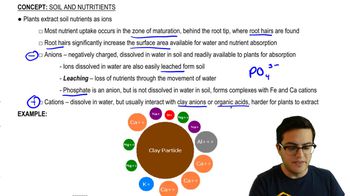Table of contents
- 1. Introduction to Biology2h 42m
- 2. Chemistry3h 40m
- 3. Water1h 26m
- 4. Biomolecules2h 23m
- 5. Cell Components2h 26m
- 6. The Membrane2h 31m
- 7. Energy and Metabolism2h 0m
- 8. Respiration2h 40m
- 9. Photosynthesis2h 49m
- 10. Cell Signaling59m
- 11. Cell Division2h 47m
- 12. Meiosis2h 0m
- 13. Mendelian Genetics4h 44m
- Introduction to Mendel's Experiments7m
- Genotype vs. Phenotype17m
- Punnett Squares13m
- Mendel's Experiments26m
- Mendel's Laws18m
- Monohybrid Crosses19m
- Test Crosses14m
- Dihybrid Crosses20m
- Punnett Square Probability26m
- Incomplete Dominance vs. Codominance20m
- Epistasis7m
- Non-Mendelian Genetics12m
- Pedigrees6m
- Autosomal Inheritance21m
- Sex-Linked Inheritance43m
- X-Inactivation9m
- 14. DNA Synthesis2h 27m
- 15. Gene Expression3h 20m
- 16. Regulation of Expression3h 31m
- Introduction to Regulation of Gene Expression13m
- Prokaryotic Gene Regulation via Operons27m
- The Lac Operon21m
- Glucose's Impact on Lac Operon25m
- The Trp Operon20m
- Review of the Lac Operon & Trp Operon11m
- Introduction to Eukaryotic Gene Regulation9m
- Eukaryotic Chromatin Modifications16m
- Eukaryotic Transcriptional Control22m
- Eukaryotic Post-Transcriptional Regulation28m
- Eukaryotic Post-Translational Regulation13m
- 17. Viruses37m
- 18. Biotechnology2h 58m
- 19. Genomics17m
- 20. Development1h 5m
- 21. Evolution3h 1m
- 22. Evolution of Populations3h 52m
- 23. Speciation1h 37m
- 24. History of Life on Earth2h 6m
- 25. Phylogeny2h 31m
- 26. Prokaryotes4h 59m
- 27. Protists1h 12m
- 28. Plants1h 22m
- 29. Fungi36m
- 30. Overview of Animals34m
- 31. Invertebrates1h 2m
- 32. Vertebrates50m
- 33. Plant Anatomy1h 3m
- 34. Vascular Plant Transport1h 2m
- 35. Soil37m
- 36. Plant Reproduction47m
- 37. Plant Sensation and Response1h 9m
- 38. Animal Form and Function1h 19m
- 39. Digestive System1h 10m
- 40. Circulatory System1h 57m
- 41. Immune System1h 12m
- 42. Osmoregulation and Excretion50m
- 43. Endocrine System1h 4m
- 44. Animal Reproduction1h 2m
- 45. Nervous System1h 55m
- 46. Sensory Systems46m
- 47. Muscle Systems23m
- 48. Ecology3h 11m
- Introduction to Ecology20m
- Biogeography14m
- Earth's Climate Patterns50m
- Introduction to Terrestrial Biomes10m
- Terrestrial Biomes: Near Equator13m
- Terrestrial Biomes: Temperate Regions10m
- Terrestrial Biomes: Northern Regions15m
- Introduction to Aquatic Biomes27m
- Freshwater Aquatic Biomes14m
- Marine Aquatic Biomes13m
- 49. Animal Behavior28m
- 50. Population Ecology3h 41m
- Introduction to Population Ecology28m
- Population Sampling Methods23m
- Life History12m
- Population Demography17m
- Factors Limiting Population Growth14m
- Introduction to Population Growth Models22m
- Linear Population Growth6m
- Exponential Population Growth29m
- Logistic Population Growth32m
- r/K Selection10m
- The Human Population22m
- 51. Community Ecology2h 46m
- Introduction to Community Ecology2m
- Introduction to Community Interactions9m
- Community Interactions: Competition (-/-)38m
- Community Interactions: Exploitation (+/-)23m
- Community Interactions: Mutualism (+/+) & Commensalism (+/0)9m
- Community Structure35m
- Community Dynamics26m
- Geographic Impact on Communities21m
- 52. Ecosystems2h 36m
- 53. Conservation Biology24m
35. Soil
Soil and Nutrients
Problem 10`
Textbook Question
Draw a simple sketch of cation exchange, showing a root hair, a soil particle with anions, and a hydrogen ion displacing a mineral cation.
 Verified step by step guidance
Verified step by step guidance1
Begin by drawing a root hair extending from a plant root. This represents the part of the plant that interacts with soil particles to absorb nutrients.
Next, draw a soil particle near the root hair. Soil particles are often negatively charged due to the presence of anions such as clay and organic matter.
On the surface of the soil particle, illustrate several anions (negatively charged ions) to indicate the negative charge of the soil particle.
Now, add a mineral cation (positively charged ion) such as calcium (Ca<sup>2+</sup>) or potassium (K<sup>+</sup>) near the soil particle. These cations are attracted to the negatively charged soil particle.
Finally, draw a hydrogen ion (H<sup>+</sup>) being released from the root hair. Show this hydrogen ion displacing the mineral cation from the soil particle, illustrating the process of cation exchange where the hydrogen ion replaces the mineral cation, allowing the plant to absorb the mineral cation.
 Verified video answer for a similar problem:
Verified video answer for a similar problem:This video solution was recommended by our tutors as helpful for the problem above
Video duration:
2mPlay a video:
Was this helpful?
Key Concepts
Here are the essential concepts you must grasp in order to answer the question correctly.
Cation Exchange
Cation exchange is a process where cations (positively charged ions) in the soil are exchanged with cations from plant roots. This is crucial for nutrient uptake, as plants release hydrogen ions (H+) into the soil, which displace nutrient cations like potassium (K+), calcium (Ca2+), and magnesium (Mg2+) from soil particles, making them available for absorption by the plant roots.
Recommended video:
Guided course

Cation Exchange
Root Hair Function
Root hairs are extensions of root epidermal cells that increase the surface area for water and nutrient absorption. They play a vital role in cation exchange by releasing hydrogen ions into the soil, which helps displace nutrient cations from soil particles, facilitating their uptake into the plant. This process is essential for the plant's nutrient acquisition and overall health.
Recommended video:
Guided course

Root System
Soil Particle Charge
Soil particles, particularly clay and organic matter, often carry a negative charge, which attracts and holds onto cations. This electrostatic attraction is the basis for cation exchange, as the negatively charged soil particles bind with positively charged nutrient ions. Understanding this charge interaction is key to comprehending how nutrients are retained in the soil and made available to plants through cation exchange.
Recommended video:
Guided course

Soil Composition
Related Videos
Related Practice




















